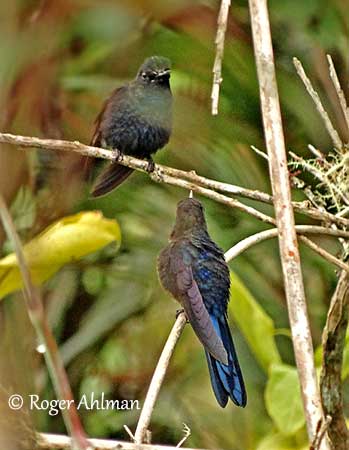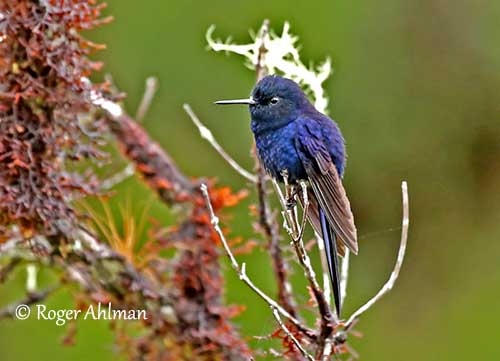
Fr: Héliange royal
Ang: Royal Sunangel
All: Königssonnennymphe
Esp: Colibrí Real
Ita: Angelo del sole regale
Nd: Peruaanse Zonnekolibrie
Sd: Kungssolängel
Photographer:
Roger Ahlman
Pbase Galleries Peru and Ecuador
Text by Nicole Bouglouan
Sources:
HANDBOOK OF THE BIRDS OF THE WORLD Vol 5 by Josep del Hoyo-Andrew Elliott-Jordi Sargatal - Lynx Edicions - ISBN: 8487334253
BIRDS OF PERU by Thomas S. Schulenberg, Douglas F. Stotz, Daniel F. Lane, John P. O’Neill, Theodore A. Parker III – Princeton University Press 2007 – Isbn: 978-0-691-13023-1
SORA – The Wilson Bulletin - A NEW SPECIES OF HUMMINGBIRD FROM PERU
By JOHN W. FITZPATRICK, DAVID E. WILLARD AND JOHN W. TERBORGH
SORA Searchable Ornithological Research Archive (Blair O. Wolf)
Royal Sunangel
Heliangelus regalis
Apodiformes Order – Trochilidae Family
INTRODUCTION:
The Royal Sunangel is included in the subfamily Trochilinae within the large family Trochilidae. It is part of the “Andean clade” in which the hummingbirds share several common features, both morphological and behavioural.
This species is usually seen at high elevation in the Andes, between 1250 and 2200 metres in humid elfin forests, shrubs, lichen-covered bushes, large ferns, but also on the sides of steep, wooded ravines.
The Royal Sunangel has small, fragmented range in which the suitable habitat is declining slowly, and the species is listed as Endangered.
The first specimen was collected on 14 July 1976 by J.W. Fitzpatrick in Cordillera del Cóndor, Peru, at 1950 metres of elevation.

DESCRIPTION OF THE BIRD:
Biometrics:
Length: 10-12 cm
Weight: 3,5-4,5 g
Bill: 1,4 cm
Outer rectrices: M: 5-5,5 cm – F: 3,9-4,2 cm
Inner rectrices: M: 2,6-2,9 cm – F: 2,6-2,8 cm
The Royal Sunangel adult of nominate race has uniform deep violet-blue plumage with shining overall, but the forecrown shows stronger blue iridescence. It has a long, deeply forked tail with dark, metallic blue rectrices. The flight-feathers are dusky with little iridescence. In poor light conditions, the plumage may appear almost black. There is a semi-concealed patch of downy white feathers on crissum in both sexes.
In both adults, the short, straight bill is black. The eyes are dark brown to blackish. Legs and feet are black.
The female is very different with dark green upperparts and buffy-brown to rich cinnamon underparts with some green, streaked/spotted pattern on the throat and whitish-buff pectoral band. The forked tail is shorter than in male and less forked.
The juvenile resembles female but it has spotted grey throat instead of green. It reaches the adult plumage at about one year old.
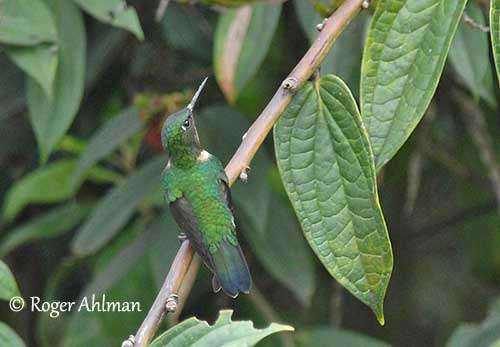
SUBSPECIES AND RANGE:
The Royal Sunangel has two subspecies.
H.r. regalis (here described and displayed) is found in extreme S Ecuador and N Peru (Cajamarcas, Amazonas) on isolated Cordillera del Cóndor and E slope of the Andes (San Martín, Loreto).
H.r. johnsoni occurs in the Andes of N Peru (Cordillera Azul). This race is brighter metallic indigo.
HABITAT:
The Royal Sunangel occurs in several types of habitats, but it frequents mainly the “elfin scrub” where it can be seen in grassland with mossy, stunted forest, stunted lichen-covered bushes, plants of family Ericaceae, succulent and bracken ferns. These habitats are adjacent to dry savanna-like areas and taller humid forest. The elfin scrub occurs mainly on ridgetops where regular fire disturbance avoids the development of taller trees.
However, the Royal Sunangel also frequents the sides of wooded ravines. It usually ranges between 1250 and 2200 metres of elevation, but it is usually more abundant above 1500 metres. In SE Ecuador, the species has been recorded in lower montane forest and well-vegetated foothills too.
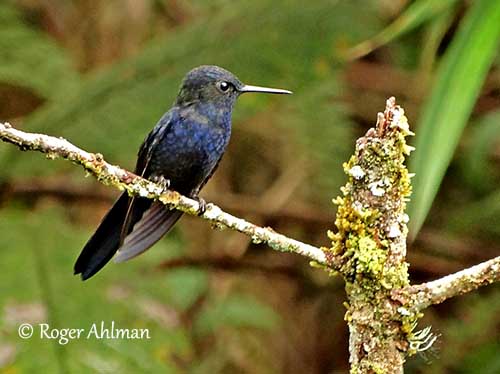
CALLS AND SONGS: SOUNDS BY XENO-CANTO
The Royal Sunangel’s call is a rich « tchip » often given in series. The male gives high-pitched, fast “chichúp chúp” whereas the female utters thin, high-pitched “tziip”.
During the aerial displays, the male performs large circles in the air while giving a high “teep” note. During disputes between males, they utter an endless, high-pitched jumble of “jijijit, jijit, jijit, jijiji…”
BEHAVIOUR IN THE WILD:
The Royal Sunangel feeds mainly on nectar from Brachyotum quinquenerve of family Melastomataceae, a low shrub with numerous flowers along multiple stems. The petals form a tubular corolla hanging vertically. The hummingbird hovers below the flower, pointing its bill straight upwards to reach the nectar. This plant is an important food source and an abundant component of the brushy habitat of this species. It feeds between 0,5 and 2 metres above the ground within the dense foliage.
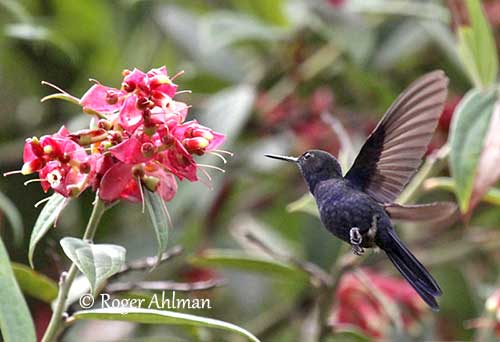
The Royal Sunangel takes the nectar through the open end of the corolla. It often feeds by perching on leave or twig below the flower, rather than hovering like most Trochilidae, probably due to the hanging position of the flower.
It also catches small insects by outwards and upwards sallies from exposed perch and then, returns to the same perch.
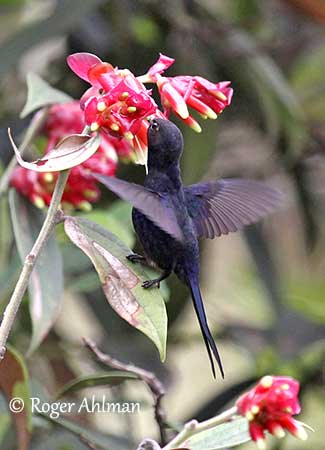
But it also feeds on nectar from other plant species if Brachyotum quinquenerve is absent from the area, and the bird can be seen on Bromeliaceae, Orchidaceae, Gentianaceae and Ericaceae species.
The Royal Sunangel is highly territorial and it is often seen perched near or over the top of the shrubs. Males chase each other while giving series of high-pitched notes. The territory of a male is about 40-50 metres in diameter and includes good stands of flowering Brachyotum in full bloom.
Some displays are observed, usually just after dawn. A male perches on an exposed twig, about 5-6 metres above the ground, and utters series of high-pitched, warbled notes. The song ends with a long flight during which the bird makes a large circle about 10 metres high and returns to its perch. Then, a second circular flight is performed on the opposite side of the perch, forming an 8-shaped flight pattern with the perch at the centre. Some single “tick” notes are given during the flight.
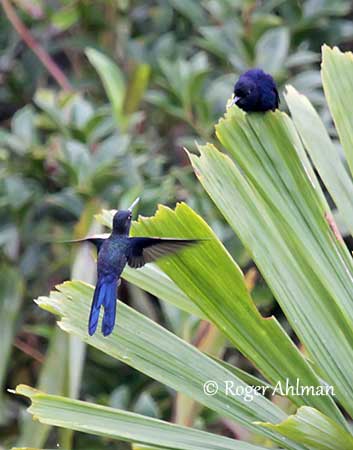
Other display shows a female perched on a twig, while a male is perched above her and frequently shifts positon, fanning its tail, holding the bill vertically and raising the wings. While flicking and vibrating wings and tail, the male gives a high-pitched series of short notes. The display ends when the female flies off.
The Royal Sunangel performs some seasonal movements, probably related to food resources and flowering trees. However, males and females seem to frequent different elevations, and the females often occur lower dawn the slopes.
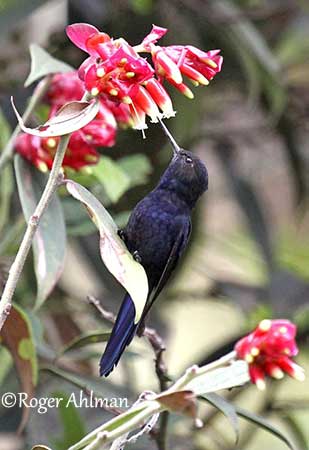
REPRODUCTION OF THIS SPECIES:
The breeding season takes place between July and September, at the onset of a dry season.
The female lays 2 white eggs and incubates alone. The duration is unknown, but in most Trochillidae, the incubation usually lasts 23-26 days. However, in the high-Andean species, this period is longer and may last between 40 and 50 days.
More information is required but the species has been recently discovered and currently, no nests have been yet located and described.
PROTECTION / THREATS / STATUS:
The Royal Sunangel has small, fragmented range of about 2100 km². The species is vulnerable to habitat fragmentation and destruction, and large areas have been recently deforested for agriculture expansion.
The population is estimated at fewer than 10,000 individuals and declining.
The Royal Sunangel is currently listed as Endangered.
